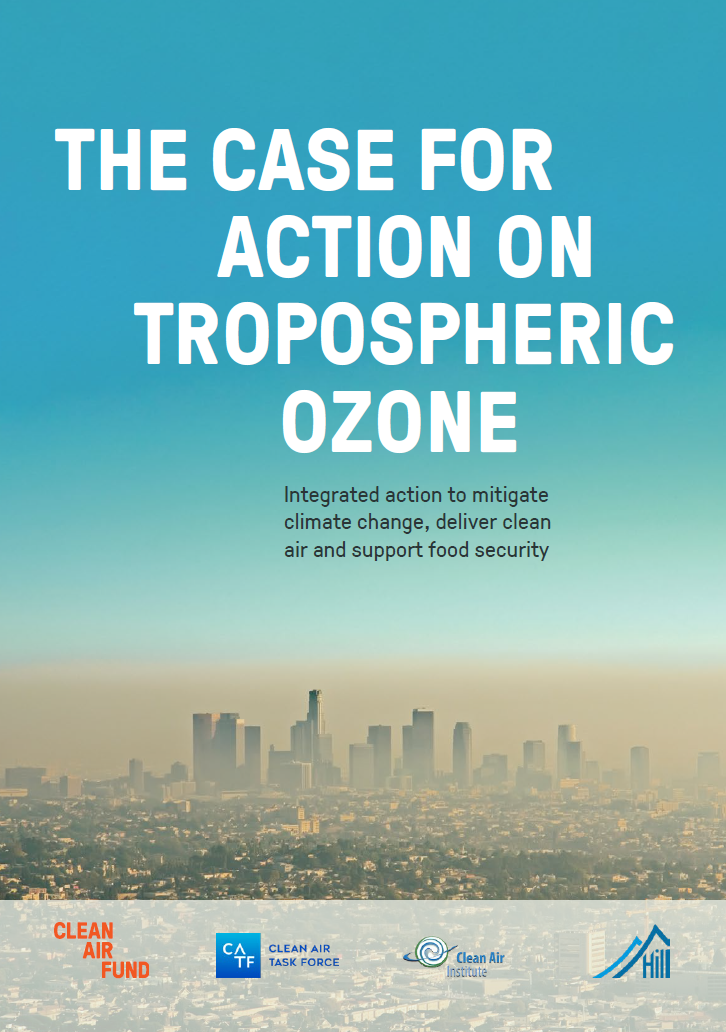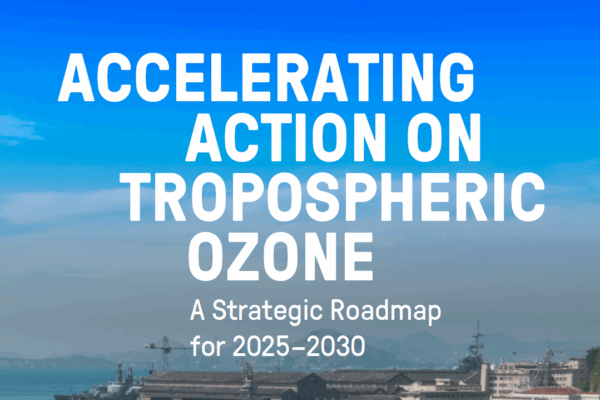
Tropospheric ozone is a greenhouse gas, super pollutant and air pollutant that is all around us. It warms the earth’s atmosphere, harms human health when inhaled, and damages crops and forests.
As a greenhouse gas, it is responsible for approximately 0.23°C of present-day warming. Yet dedicated action to reduce tropospheric ozone is absent from the climate policy agenda at a global, regional, and country level. As it’s one of the super pollutants driving half of global warming, this needs to change.
Tropospheric ozone (which includes ground-level ozone) is not emitted like many other gases and particles, but rather formed in the atmosphere when sunlight interacts with a suite of other pollutants. The main ingredients driving elevated levels of this toxic air pollutant are methane (a potent greenhouse gas), nitrogen oxides, non-methane volatile organic compounds, and carbon monoxides. These ‘precursors’ are emitted from a range of sectors, including transport, industry, livestock and energy generation – as well as wildfires.
Explainer: ‘good’ ozone versus ‘bad’ ozone
Ozone can mainly be found in two layers of the Earth’s atmosphere. Tropospheric ozone, or ‘bad’ ozone, refers to ozone that is present in the atmosphere up to about 15 kilometers above ground-level. In this layer, ozone acts as a greenhouse gas and super pollutant, contributing significantly to global warming by absorbing infrared radiation and thereby heating the surrounding air. At the bottom of this layer – the Earth’s surface – tropospheric ozone is often referred to as ‘ground-level ozone’. Here, it is responsible for almost half a million premature deaths per year and substantial reductions in agricultural crop yields.
Ozone plays a very different role in the stratosphere – the layer of the atmosphere from approximately 15 to 40 kilometers above the Earth’s surface. Here, ozone protects us by absorbing harmful ultraviolet radiation through the ozone layer. This is the ‘good’ ozone layer that is protected by the internationally negotiated Montreal Protocol.
Stratospheric (‘good’) and tropospheric (‘bad’) ozone are interlinked. The good news is that we can simultaneously protect the beneficial ozone layer while acting to reduce harmful tropospheric ozone levels. There is also growing evidence that increasing levels of tropospheric ozone and other greenhouse gases may erode stratospheric ozone, thereby increasing the importance and urgency of action on tropospheric ozone and climate change more broadly.
Untapped potential for a triple win
Reducing tropospheric ozone has untapped potential to mitigate the impact of human-induced climate change over the coming years. At the same time, targeted action can deliver cleaner air, reducing the half a million premature deaths and the $500 billion in economic costs associated with tropospheric ozone each year. Action on tropospheric ozone also improves agricultural yields for staple crops on which billions of people rely, like maize, rice and wheat.
Cutting tropospheric ozone presents a unique challenge as it requires smart and fast action across multiple greenhouse gases and air pollutants, as well as multiple economic sectors. It is a growing and neglected problem that needs an integrated approach on both a local and global level to tackle climate change and air pollution together, alongside accelerated efforts to translate science into policies.
Despite this complexity, progress is possible. This briefing showcases efforts in cities and regions – including Los Angeles, Mexico City, Beijing and Europe – that have successfully reduced levels of tropospheric ozone through targeted pollution control.
Reducing tropospheric ozone can provide a triple win for:
1. Climate
Reducing tropospheric ozone levels would make a major contribution to avoiding further global temperature rises in the coming decades. Tropospheric ozone levels have increased significantly over the last century. Since 1995, they have gone up between 2-12% per decade, depending on the region, driven largely by rapid industrialisation and urbanisation. They are estimated to have contributed to 0.23°C of global warming from 1750 to the present. Cutting super pollutants, including tropospheric ozone, can mitigate warming nearly four times faster than decarbonisation alone.
Significant actors in climate action are waking up to this urgent issue. Earlier this year, the US and Chinese governments identified the need for technical cooperation and capacity building to develop abatement solutions for tackling tropospheric ozone as part of efforts to combat climate change.
2. Health
Tackling tropospheric ozone would bring major health benefits by rapidly improving air quality. Tropospheric ozone poses serious health risks. It contributes to respiratory issues, reduces lung function, and exacerbates chronic conditions like asthma, bronchitis and emphysema. It has also been linked to complications in type 2 diabetes and cardiovascular disease.
Nine out of ten people are exposed to tropospheric ozone levels that exceed WHO guideline levels, contributing to almost half a million premature deaths each year. Meeting the WHO’s guidelines would save hundreds of thousands of lives and provide economic benefits of up to $500 billion per year, through avoided healthcare costs and a healthier, more productive workforce.
3. Agriculture
Tropospheric ozone severely damages many staple crops, leading to reduced grain size, fewer seeds, slower growth rates and less resilience to environmental stresses. It also accelerates the leaf aging process and causes plants visible injury, like chlorosis or necrosis.
The result is significant losses in global crop yields. For staples such as wheat, soyabean and maize, total economic losses due to ozone damage could amount to $35 billion annually by 2030, if calculated using 2000 prices. Tackling tropospheric ozone would improve food security globally by increasing yields for the crops that feed billions of people.
Recommendations for smarter action
There are concrete steps that governments and other decision makers can take now. Many of these are aligned to existing efforts such as the Global Methane Pledge and delivering on World Health Organization (WHO) Air Quality Guidelines. This report explores policies and measures by sector and precursor pollutant, given that each location will experience a different mix of precursors depending on their sources.
At the same time, further research and scientific leadership is needed to better understand the considerable benefits of reducing tropospheric ozone and fill knowledge gaps holding us back from mitigating climate change at pace.
Our recommendations for policy makers, scientists, and funders set out action that can be taken now. We urge bold steps to secure the considerable benefits these measures will bring, including faster climate change mitigation, cleaner air for billions of people, and improved global food security.
How to cite this report
Cite as: THE CASE FOR ACTION ON TROPOSPHERIC OZONE: Integrated action to mitigate climate change, deliver clean air and support food security. Clean Air Fund, Clean Air Institute, Clean Air Task Force, Hill Consulting. Nov, 2024. www.cleanairfund.org/resource/action-on-tropospheric-ozone/

